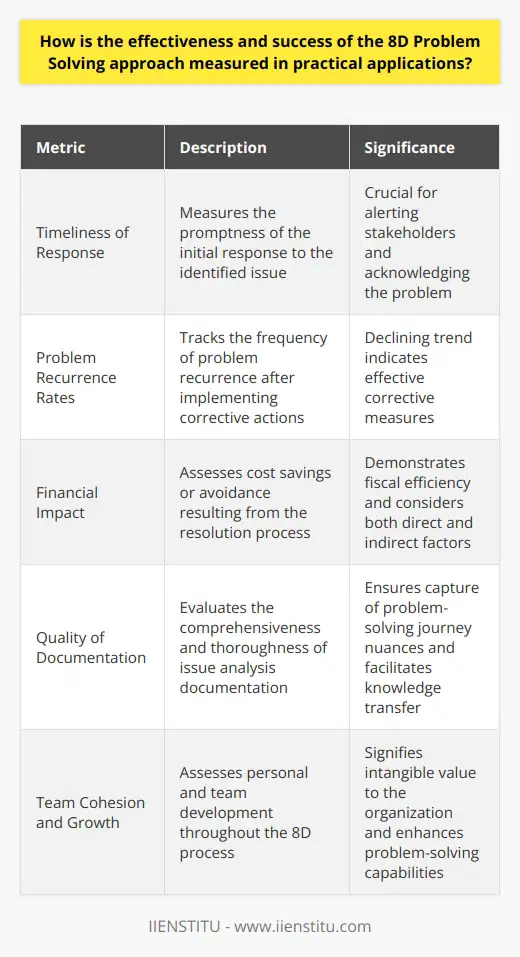
The 8D problem-solving process stands as a beacon of structured analysis and corrective action within the complexities of operational pitfalls and quality control discrepancies across industries. Originating from the automotive industry and since adopted widely, the methodology offers a meticulous step-by-step approach that fosters team cohesion, addresses problems at their roots, and implements sustainable solutions.
This article seeks to delve into the nuances of the 8D problem-solving framework, presenting a lucid exposition of its origins, a detailed foray into each step enriched by practical examples, and concluding with the unequivocal benefit bouquet it presents to the organization adopting it.
The Origins of the 8D Problem Solving Methodology
The 8D, or "Eight Disciplines," problem-solving approach germinated from the fertile grounds of collaborative efforts to ensure superior quality and reliability in manufacturing. Initially developed by the Ford Motor Company in the 1980s, this systematic method was a response to a confluence of quality and operational issues that were pervasive in the automotive industry. It drew broader appeal as its efficacy became apparent - functioning as an amalgam of logic, analytics, and teamwork to tackle problems methodically.
The wide reach of the 8D methodology is evident in industries ranging from manufacturing to healthcare, aerospace to IT, and beyond. Its universal applicability stems from a foundational adherence to principle over process, transcending the intricacies of industry-specific challenges. By combining reactive and proactive measures, the 8D method helps in not just extinguishing the fire, but also preventing its outbreak, making it an enduring asset in the organizational toolkit.
The 8 Steps of Problem Solving
An incursion into the 8D methodology reveals a framework that is both systematic and flexible. Each step is sequenced to ensure that issues are not merely patched but genuinely resolved, implementing robust preventive measures to curtail recurrences. This section expounds on each disciplinary step and serves as a substrate for practical implementation examples, supplementing theoretical insights with real-world applicability.
Step 1: Establish a Team
The cornerstone of any formidable 8D approach begins with assembling a competent team. The wisdom embedded in this initial phase is the recognition that effective problem-solving is not a solitary venture but a collaborative pursuit. A multidisciplinary team brings diverse perspectives that are critical in diagnosing issues accurately and devising solutions effectively.
When determining team composition, the emphasis should be on a mix of skills and expertise relevant to the problem at hand. Roles within the team should be clearly defined to streamline activities and foster accountability. Each member should be well-versed in their responsibilities, from those leading the problem-solving charge to those executing and tracking actions.
Step 2: Describe the Problem
Clarity is vital in the second step, which necessitates delineating the problem with precision. A meticulous description sets the foundation for targeted analysis and actionable solutions. It involves accruing information that is factual, quantifiable, and devoid of assumptions – the cornerstone of an accurate problem portrayal.
Techniques like '5W2H' (who, what, when, where, why, how, how much) can galvanize teams into crafting detailed problem descriptions. An exemplar of a well-articulated problem statement might state, "Machine X has experienced a 15% decline in output quality, resulting in a monthly loss of 200 units of product Y since January due to recurrent mechanical inaccuracies."
Step 3: Develop Interim Containment Actions
Addressing a problem's immediate impact is pivotal to prevent exacerbation as a root cause analysis is conducted. Interim containment actions can be likened to first aid – essential, though not the definitive cure. These measures should be rigorously designed to quell the problem's spread or intensification without creating new issues.
An interim action for the aforementioned issue with Machine X could involve adjusting the production schedule to mitigate output loss while the machine is under examination. This demonstrates a temperate solution, buying time for a comprehensive fix without severely disrupting the production chain.
Step 4: Define and Verify the Root Cause(s)
Singular in its focus yet pluralistic in its approach, this phase is committed to uncovering the underlying reasons for the problem. Root cause identification is a task of surgical precision, necessitating a deep dive into the problem without the constraints of predetermined notions.
Techniques such as the "5 Whys" and "Fishbone Diagram" guide problem solvers through a structured investigation of potential causes. Verification is as crucial as identification, ensuring that purported root causes stand up to scrutiny and testing.
Step 5: Verify Permanent Corrective Action(s)
Once root causes have been established, attention shifts to devising and validating long-term corrective actions. This step traverses the path from theory to practice. It requires a judicious appraisal of potential solutions with a clear-eyed view of their feasibility, effectiveness, and sustainability.
Best practices in this step incorporate piloting solutions on a smaller scale, enabling refinement before full-scale implementation. A well-considered corrective action for Machine X might involve upgrading mechanical components identified as failure points, subject to cost-benefit analysis and potential disruption to the production line.
Step 6: Implementing and Validating Permanent Corrective Actions
This step transitions the plan into reality, pushing the corrective actions beyond the threshold into the operational environment. Careful implementation is the linchpin, with detailed plans and schedules ensuring that actions are well-executed and efficacious.
The validation process is a keystone in affirming that corrective actions deliver the intended improvements. For Machine X, this could entail monitoring post-repair performance metrics over a defined period against pre-issue levels to authenticate the efficacy of the improvements.
Step 7: Preventive Measures
Armed with insights gleaned, the 7th step propels the methodology into preventative mode. Here, the onus is on forestalling a problem’s resurgence by ingraining the lessons learned into the organizational fabric. The aim is to encapsulate these insights in policies, procedures, or system changes.
This could mean revising maintenance schedules or worker training programs for Machine X to include the specific nuances that led to the mechanical inaccuracies, thereby shielding against repeat episodes.
Step 8: Congratulate Your Team
The final step encompasses a human-centered focus on recognition and commendation. Acknowledgment of the team’s efforts reinforces motivation, fosters a positive culture, and encourages engagement in future problem-solving initiatives.
Celebrating the success could manifest in a ceremonious recognition of the team’s achievements, an internal announcement of their contributions, or a tangible expression of appreciation. This not only cements the accomplishment but also propels a sense of camaraderie and collective purpose.
The Importance of the 8D Problem Solving Process
A mature consideration of the 8D problem-solving process corroborates its contributory significance in unraveling complex issues and instituting consequential improvements. The benefits it confers are manifest in enhanced product quality, heightened customer satisfaction, and the stimulation of a proactive problem-solving culture. Challenges do persist, mainly in the form of resistance to change or insufficient training; nevertheless, with a conscientious implementation, these can be navigated.
Moreover, the 8D approach aligns seamlessly with the pursuit of continuous improvement – a cornerstone of many business philosophies such as Lean and Six Sigma. It thus serves not only as a solution framework but also as a catalyst for organizational growth and learning.
In summary, the 8D problem-solving methodology stands out for its disciplined, team-driven, and methodical approach to tackling complex problems. From its historical roots in the automotive industry to its implementation in modern enterprises, its efficacy in achieving sustainable solutions is undoubted. Online certificate programs and problem-solving courses often feature 8D due to its relevance and value across industries.
As this article delineates each step, with practical applications and advice, the message is clear: mastery of 8D is not just for immediate problem resolution – it is a pathway to building a resilient and adaptive organization capable of facing the challenges of an ever-changing business landscape.
Frequently Asked Questions
What are the key steps involved in the 8D Problem Solving process and how do they interact with each other?
Introduction to the 8D Process
The 8D Problem Solving process stands tall. It is a structured approach. Businesses use it widely. 8D tackles complex problems effectively. It drives teams towards lasting solutions. It also fosters quality and reliability. The "D" denotes eight disciplined steps. These steps guide teams. They identify, correct, and prevent issues.
8D Steps Explained
D1: Establish the Team
Form a skilled team first. Diversity matters here. Each member brings insights. Their combined expertise is crucial. Team formation kicks off the process.
D2: Describe the Problem
Articulate the issue clearly. Use quantifiable data here. Understanding the scope matters. Have accurate problem statements ready. They pave the way forward.
D3: Develop Interim Containment Action
Ensure a temporary fix. It limits the problem's impact. Speed is of the essence. However, ensure the action is effective. The goal is to stabilize the situation.
D4: Determine Root Cause
Dig deep into causes. Use data-driven analysis. Techniques include fishbone diagrams. Five Whys is also popular. Root cause analysis is pivotal. It prepares the team for corrective actions.
D5: Design and Verify Permanent Corrective Actions
Choose the best corrective action. Rigorous selection criteria apply. Effectiveness and efficiency matter. Verify through testing. Make certain the solution fits.
D6: Implement and Validate Permanent Corrective Actions
Roll out the solution. Watch closely for results. Validation takes place here. Use performance indicators for this. They must indicate that the solution works.
D7: Prevent Recurrence
Embed the improvement. Update systems and policies. Training may be necessary. Maintain the gains. This step safeguards the future. Documentation is important here.
D8: Congratulate the Team
Never overlook recognition. Acknowledge everyone's efforts. Celebrate the success achieved. It boosts team morale. It also promotes a culture of quality.
Interplay Between Steps
The interdependence is strong. Each step builds on the previous one. For example, a strong team in D1 enhances problem understanding in D2. Similarly, effective interim actions in D3 set the stage for a thorough root cause analysis in D4.
The verification in D5 ensures the solution from D4 is sound. Implementation in D6 then relies on the verified action. To prevent recurrence (D7), one must understand the root cause. The entire process relies on clear communication. Team recognition (D8) closes the loop neatly. It paves the way for future problem-solving success.
In essence, the 8D steps are interlinked. Each step informs the next. Teams achieve the best results by following the sequence. They also adapt as needed. 8D enforces a discipline that leads to high-quality results. The interaction between steps ensures problems do not just disappear. They stay solved. This is the power of an integrated problem-solving approach.

Can you provide some practical examples of the effective application of 8D Problem Solving strategies in real-life settings?
Understanding 8D Problem Solving
8D problem solving stands for Eight Disciplines. It involves steps that teams must follow. Starting from identifying problems, it goes until preventing reoccurrences. Companies use 8D to tackle complex issues. Its main goal remains quality improvement.
Here are practical examples where 8D shines.
Example 1: Automotive Industry
D0: Plan - An auto manufacturer formed a team. Their goal was clear: resolve brake failures.
D1: Team Formation - They gathered experts from diverse fields. Collaboration was key here.
D2: Describe the Problem - They identified specific issues. Customers reported brakes failing at high speeds.
D3: Develop Interim Containment - They distributed quick-fix kits to dealerships. This ensured immediate customer safety.
D4: Determine Root Causes - A deep dive ensued. The team discovered a faulty brake fluid line.
D5: Choose and Verify Permanent Corrective Actions (PCAs) - They redesigned the brake line. Then they tested it under rigorous conditions.
D6: Implement and Validate PCAs - The new design went into production. Ongoing assessments confirmed its effectiveness.
D7: Take Preventive Measures - They updated their design guidelines. Thus, they eliminated the possibility of similar failures.
D8: Congratulate Your Team - Management recognized the team's effort. This promoted a culture of problem-solving.
Example 2: Electronics Manufacturer
D0: Plan - A sudden surge in returned gadgets prompted action.
D1: Team Formation - A cross-functional team took charge. They had one aim: find the flaw.
D2: Describe the Problem - Devices were overheating during usage. Anxiety among customers grew.
D3: Develop Interim Containment - They halted the production line. Assessing risks was necessary.
D4: Determine Root Causes - Detailed analysis revealed a substandard battery component.
D5: Choose and Verify PCAs - They sourced a higher quality component. Subsequent tests showed promising results.
D6: Implement and Validate PCAs - They integrated the new component into production. Monitoring phases ensured it was a fix.
D7: Take Preventive Measures - They revamped their quality control protocols. Now they could avoid similar issues.
D8: Congratulate Your Team - The team's innovative approach earned praise. They set new standards in their processes.
Example 3: Food Packaging Company
D0: Plan - Reports of packaging leaks triggered an 8D.
D1: Team Formation - Experts from production to distribution joined forces. They understood the stakes were high.
D2: Describe the Problem - The leaks were sporadic but damaging. Food safety concerns escalated.
D3: Develop Interim Containment - They removed compromised products from shelves. Protecting the consumer was paramount.
D4: Determine Root Causes - Investigation exposed a sealing machine defect.
D5: Choose and Verify PCAs - Engineers redesigned the sealing mechanism. Trials followed, proving success.
D6: Implement and Validate PCAs - The updated machines replaced the old ones. Continuous evaluations followed to assure quality.
D7: Take Preventive Measures - They introduced more rigorous maintenance routines. They aimed to preempt future failures.
D8: Congratulate Your Team - The swift and thorough response earned accolades. They reinforced trust in their brand.
8D's Practical Value
Each example showcases 8D's potential. This problem-solving framework adapts to various scenarios. Through structured teamwork and analysis, it guides toward sustainable solutions. It helps in ensuring the same problem does not occur twice. Businesses across different sectors find 8D crucial for their continuous improvement efforts. It underlines that a methodical approach to problem-solving can yield significant long-term benefits.

How is the effectiveness and success of the 8D Problem Solving approach measured in practical applications?
Introduction to 8D Problem Solving
The 8D Problem Solving approach stands as a structured methodology. It aims to address and resolve critical issues within an organization. Rooted in the team-oriented approach, 8D follows eight disciplined steps. These steps ensure a comprehensive and effective resolution process. The process includes identifying the problem, implementing interim controls, defining root causes, developing a corrective action plan, taking corrective actions, validating those actions, preventing recurrence, and finally congratulating the team.
Measuring Effectiveness and Success
Quantitative Metrics
Timeliness of Response
The promptness of the initial response is critical. It alerts stakeholders to the emergence and acknowledgment of the issue.
Problem Recurrence Rates
A key success indicator is the frequency of problem recurrence. A declining trend signifies effective corrective actions.
Financial Impact
Cost savings or avoidance measures the fiscal efficiency of the resolution. It counts both direct and indirect factors.
Cycle Time Reduction
Improvements in processes can lead to shorter cycle times. This reflects efficiency gains from the 8D implementation.
Qualitative Metrics
Quality of Documentation
Comprehensive documentation ensures thorough issue analysis. It captures the nuances of the problem-solving journey.
Stakeholder Satisfaction
Feedback from affected parties gauges the outcome’s acceptability. Satisfaction levels can direct future interventions.
Knowledge Transfer
Disseminating learnings enhances organizational capability. Sharing insights leads to broader, preventive measures.
Team Cohesion and Growth
Personal and team development signal process benefits. Such growth provides intangible value to the organization.
Practical Application and Continuous Improvement
In practical applications, tailoring metrics to contexts is vital. Unique business environments demand specific success criteria. Therefore, adapting the approach and its measurement system is necessary.
Organizations may employ a combination of tangible and intangible metrics. Aligning these to strategic goals ensures relevance. The 8D Process receives fine-tuning through iterative cycles. Each cycle offers an opportunity for enhanced problem-solving efficacy.
The Importance of Measure Standardization
Standardizing the measurement process ensures consistency. It aids in comparing and benchmarking against best practices. Homogeneity in measures facilitates clearer communication. It enhances the understanding of successes and areas for improvement.
Revisiting and Refining the 8D Process
Upon completion, a rigorous review of the 8D process is crucial. It ensures learnings lead to process refinement. Alterations in measures might follow to better reflect evolving business needs. This ongoing evolution drives the sustained value of the 8D methodology.
The 8D Problem Solving approach, with its disciplined steps, delivers a robust framework. Measuring its effectiveness requires a blend of quantitative and qualitative metrics. These metrics, when standardized and continually refined, offer a clear lens to assess the 8D process's success. They help organizations not just to solve problems but to evolve in their problem-solving capabilities.



